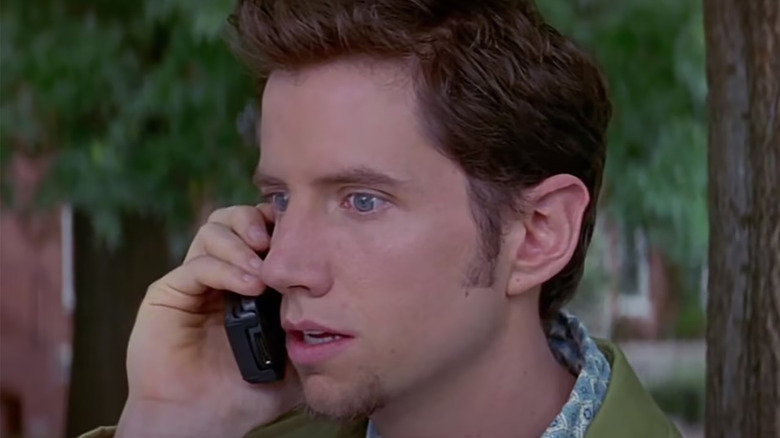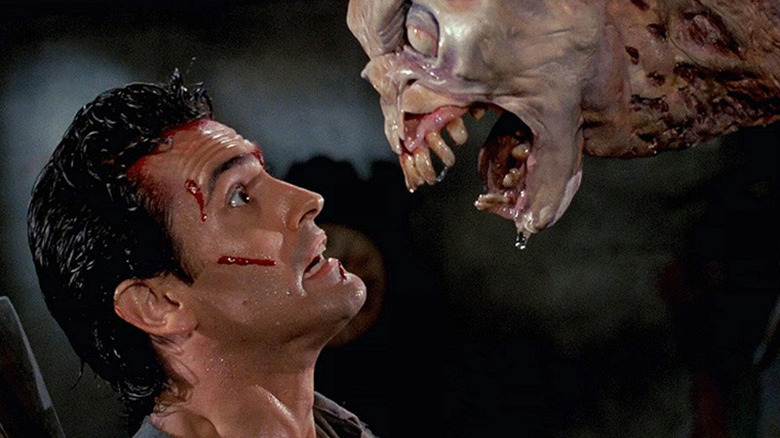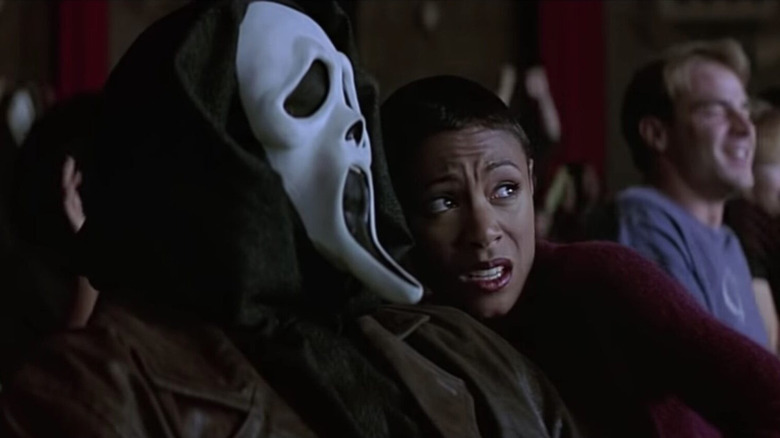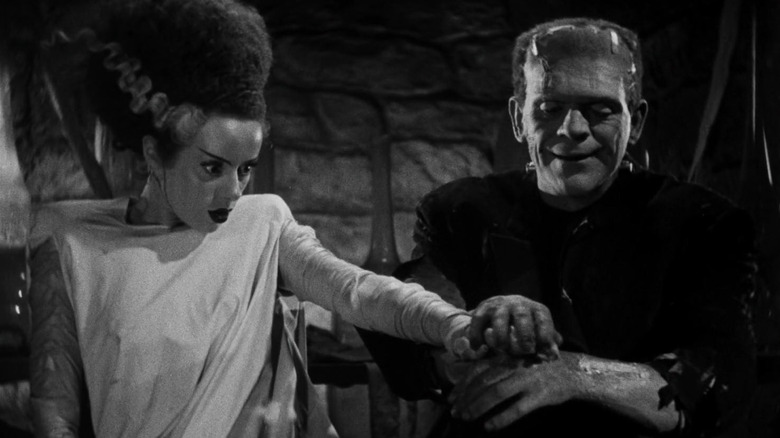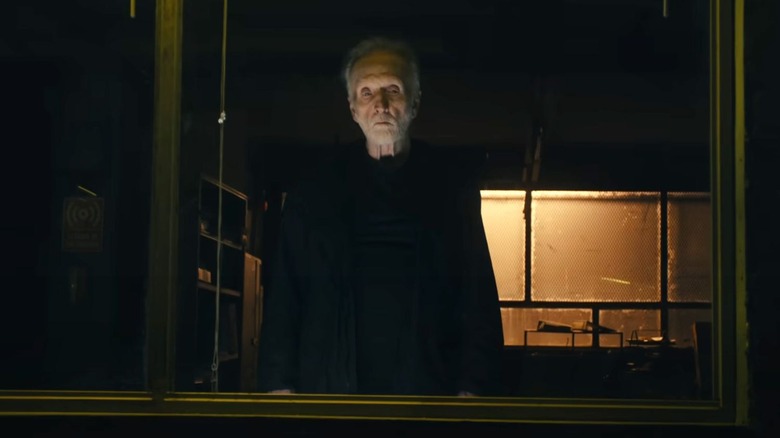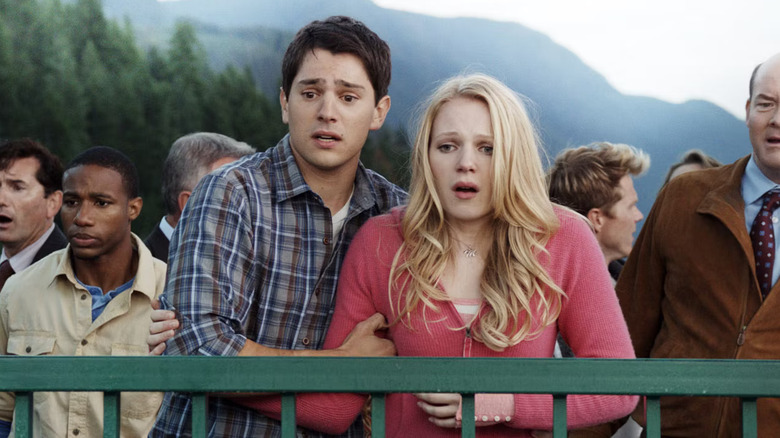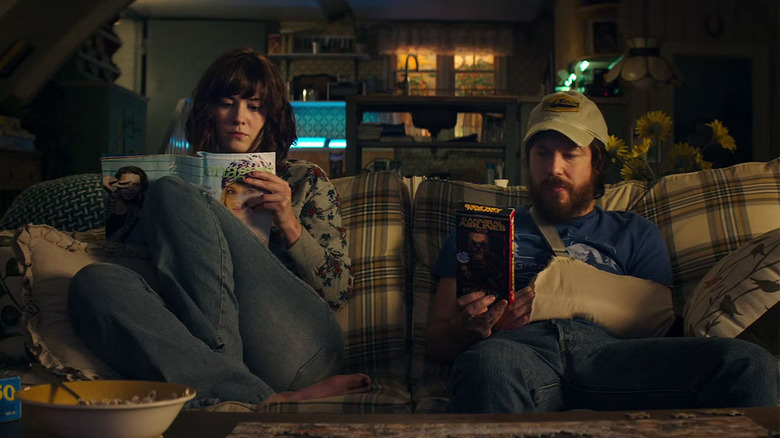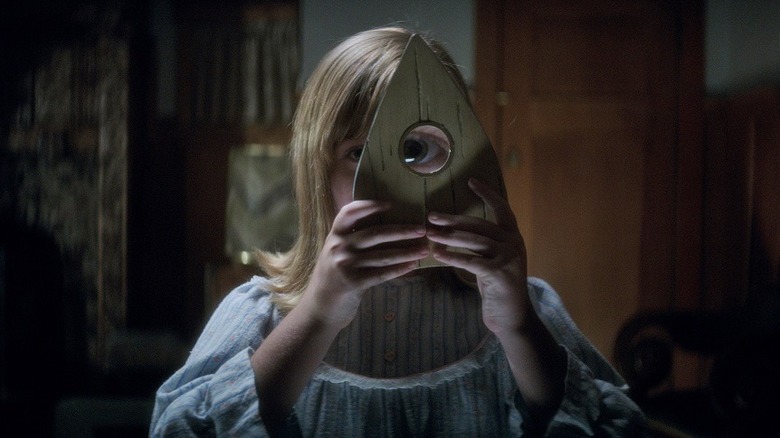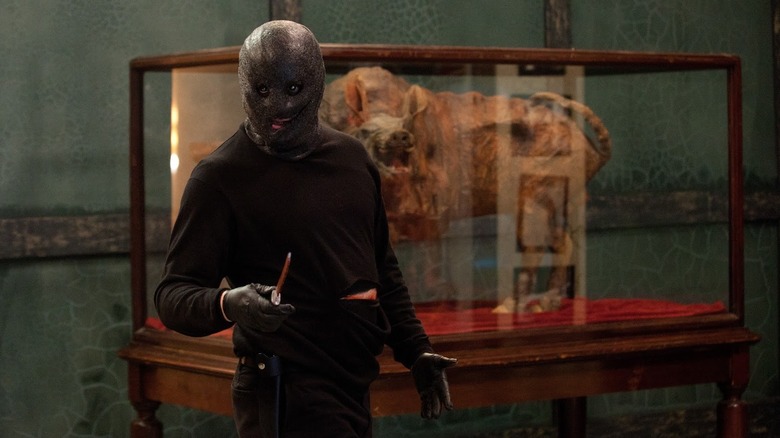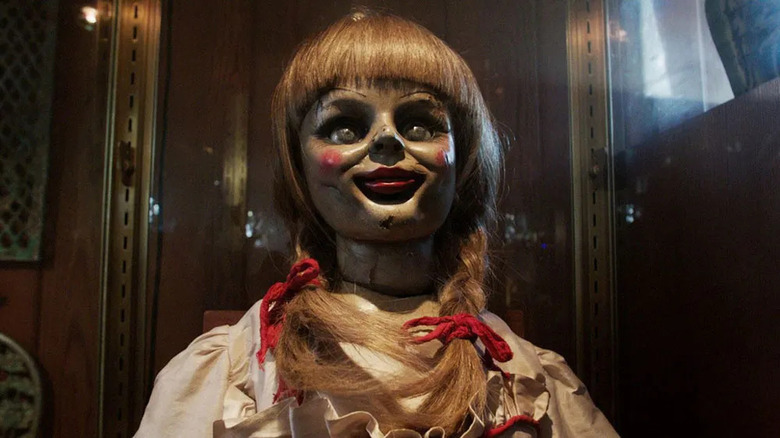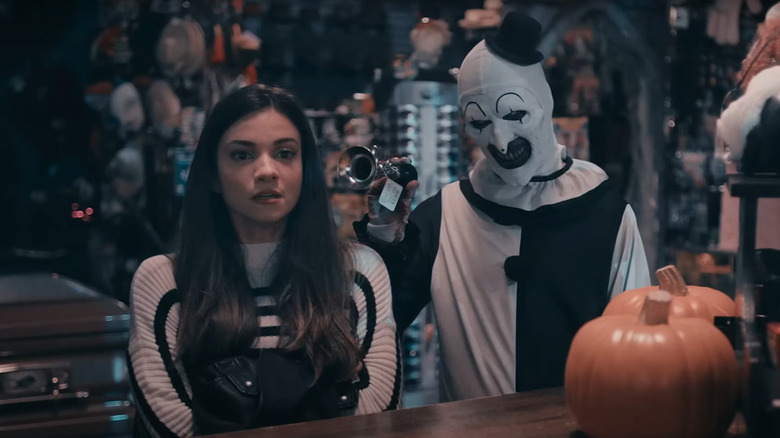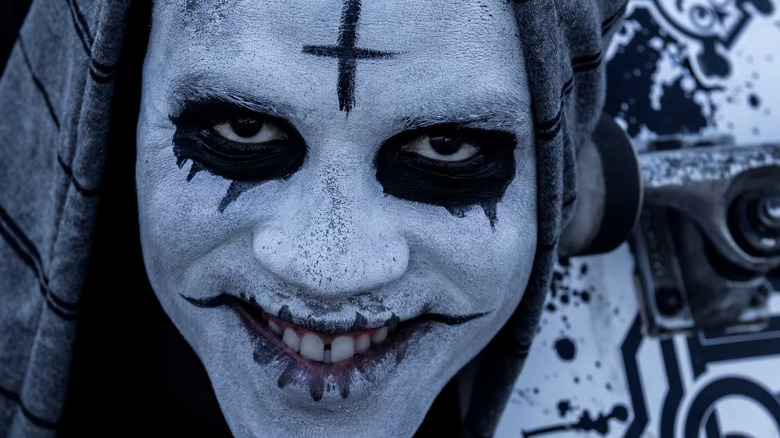Horror Sequels With Better Rotten Tomatoes Scores Than The Original
Sequels tend to rub people the wrong way. Sure, audiences will go see them, but they'll certainly bemoan their initial announcements and speculate about their quality before seeing a single frame. There's an inherent, deafening cynicism. Meanwhile, if you talk to hardcore horror fans, the sequel is given far more goodwill. A variety of major horror franchises have seen many sequels prolong their legacies and become part of the genre's fabric. Though these sequels are far from perfect, they are never boring. In fact, horror sequels tend to up the ante following the original film's success, leading to massive swings that are rejected by the masses but are wholly embraced by the more open-minded horror fanbase.
Unfortunately, this is all difficult to translate in the era of rating aggregates like Rotten Tomatoes. Yes, despite the last few years revealing its inherently broken system, the Warner Bros. Discovery and NBCUniversal-owned company remains a quick and easy seal of approval (or lack thereof) for 33% of millennial moviegoers (via Morning Consult). By their metrics, most horror sequels sit rotten next to their predecessors. However, there are exceptions to the rule, some of which help to illustrate the power of an imaginative sequel's strong cult following. Here are some of horror's freshest sequels, as decided by the Tomatometer.
Evil Dead II reimagined The Evil Dead as a slapstick horror comedy
Director Sam Raimi took the horror world by storm when he released "The Evil Dead," a low-budget possession film that featured some of the gnarliest, most impressive gore seen in the genre to date. The film's sequel, "Evil Dead II," is both a continuation and a reimagining of the original, infused with a manic comic energy that turns the entire concept on its head. Filled with uproarious slapstick and a wickedly delightful self-awareness, "Evil Dead II" is an entirely different ride from its predecessor but one that has since been deemed superior. On Rotten Tomatoes, the sequel currently sits at 88%, while "The Evil Dead" ranks just a few points lower at 86%, each with 84 reviews.
Both films are gleefully twisted for horror fans, however "The Evil Dead," at least on its face, plays like a harrowing, intense horror-drama. There's no shame in that, but it's hard to deny the greater pleasures derived from the sequel's more intentional, unabashed hilarity. Much of this comes from star Bruce Campbell, who is allowed to fully let loose in a performance that has since defined him as a horror icon. Both films are classics, but "Evil Dead II" saw Raimi more fully come into his own as a singular storyteller.
Scream 2 added moving drama to its franchise's scathing satire
The one point discrepancy between the Tomatometer scores of both "Scream" (81%) and "Scream 2" (82%) may surprise casual onlookers. After all, in the zeitgeist, "Scream" is a bonafide classic, a slasher satire that was as biting in its jabs at the genre as it was thrilling in its ability to subvert them. The sequel doesn't come close to its level of status or influence, yet enough critics believe the sequel is just as good to warrant a higher score? What gives?
Well, Rotten Tomatoes' improperly weighted system may have something to do with it. "Scream" sits at 88 reviews while "Scream 2" sits at 84 reviews; "Scream" technically has a greater number of positive reviews, however, less total reviews allow for the sequel's percentage to sit above the original. This doesn't take away from the fact that "Scream 2" is a great film; not only it is another scathing send-up, this time targeted at both the tired nature of sequels as well as media's exploitation of true crime, but it's also a more moving drama that takes its characters — and, by extension, their gruesome deaths — more seriously. It's no surprise that, for some horror fans, "Scream 2" is the best movie in the franchise.
Bride of Frankenstein infused heart into its horror
In another surprising twist, the enduring legacy of 1931's "Frankenstein" can't quite match up to critics and historians' reverence for 1935's "Bride of Frankenstein." The sequel holds a 98% on the Tomatometer, a rare feat on the platform, while the original sits at a respectable 94%. Nobody will deny that the monster's initial outing scared audiences out of their wits in a way nothing else had at the time. However, what scared audiences then doesn't necessarily scare audiences today. James Whales' original film is still gorgeously gothic but not necessarily edge-of-your-seat horror. Thankfully, the film is so much more than a horror film; it's a tragic fable exploring the disparity between humans and humanity.
"Bride of Frankenstein" continues this thematic exploration, though it relies less on horror and more on heart. Screenwriters William Hurlbut and Edmund Pearson revisit previously cut subplots from the source material, including the introduction of an old, blind hermit who embraces the Monster as a friend and teaches him how to speak – something that has become a staple of the character ever since. That scene alone, combined with the already beautiful cinematography and disturbing imagery of Whale's directorial style, simply notches this entry up a few pegs. It's wild to think the movie almost didn't make it past the Hays Code censorship back in the day.
Saw X became the franchise's first critical darling
The "Saw" franchise has never been a critical darling. Prior to 2023, not a single film in the long-running torture porn series earned a fresh rating on Rotten Tomatoes. It came the closest with its debut film in 2003, and even that fell short at only 50%. So when "Saw X," the tenth film in the franchise and the first to bear the "Saw" moniker in over a decade," came out to widely positive reviews from critics, it was such a surprise that it made headlines.
In fairness, the original "Saw" has been widely reappraised thanks to a variety of factors: its financial success, fervent cult following, and longevity as a franchise, amongst others. The film's violent ingenuity is seen as top shelf of its kind, no matter how squeamish it makes us. However, "Saw X" saw a greater focus on the character of John Kramer, known as the killer Jigsaw, portrayed by series stalwart Tobin Bell. This time, the wickedly clever traps had more motivation behind them, and this new approach from writers Peter Goldfinger and Josh Stolberg has already borne fruit. The sequel to "Saw X" is already scheduled for 2025, so we could see the franchise hit new peaks on the Tomatometer sooner than we think.
Final Destination 5 earned the franchise's first fresh rating
Similar to "Saw," the "Final Destination" franchise has had a rough go with critics. The first film, released in 2003, debuted at 35% on Rotten Tomatoes and has since gone up only one point. Critics cited its teenage drama as unsophisticated and trite, however its inventive premise and spine-chilling death sequences made it the newest horror sensation. This spawned two sequels that ranked higher on the Tomatometer at 50% and 43% respectively; the second film's ingenious highway pile-up alone made it a worthy successor, but none of the initial trilogy's stories live up to the thrills that surround them (Devon Sawa innocent though).
The fourth and originally final installment, simply dubbed "The Final Destination," debuted at 30% and has since sunk to 19%. However, the franchise thankfully saw another day with "Final Destination 5," which rocketed the franchise to its first fresh rating at 63%. "Final Destination 5" didn't bring any particular prestige to the franchise, but it did bring some of its most gruesome kills, an inventive twist on its fight with Death, and the return of Tony Todd as coroner William Bludworth. Plus, there's quite the surprise at the end for longtime fans. It was enough of a return to form to greenlight a sixth installment, which means a new topper to the franchise's tomato totem pole could be within reach.
Cult of Chucky revived Child's Play with silly, sinister camp
"Child's Play" has had a fascinating evolution. It began with the eponymous first film, which remains a miracle of a slasher. The film's premise is absurd — it's a doll for crying out loud — yet it commits to every kills, committed performances, and a strong technical achievement in Chucky himself. It was lauded by critics and continues to stand the test of time, currently sitting at 74% with 54 reviews.
Chucky's next two outings were fairly maligned, however it was "Bride of Chucky" that saw creator Don Mancini revisit the original film's bizarre tone and dial it up to 11. "Bride" sits at a rotten score (48%), but it set the series on a campy, absurdist, and queer trajectory that has so far culminated in "Cult of Chucky," the franchise's highest-ranked film at 81%. It may only be from 26 reviews, but the response is clear: "Cult" balances the silly and the sinister with comic ease, setting a new standard for the franchise.
That said, most fans will tell you that Mancini's television show, dubbed "Chucky," is where things get really good. Given the freedom to integrate fan-favorite characters and explore queer identity, the hilariously sardonic series has been wholly embraced by fans and critics; its first season is Certified Fresh at 89% and its third season, from 13 reviews, is adorned with a flawless 100%.
10 Cloverfield Lane was not your average sequel
Most franchises use sequels as an opportunity to recycle what made the original film successful. "10 Cloverfield Lane" doesn't do this. In fact, without its title, there are no explicit ties between it and its predecessor, "Cloverfield." The films inhabit different genres, focus on different characters, and vary in Tomatometer score — the first has a 78% while the second has a 90%, suggesting a difference in quality. However, these are strengths, not weaknesses, for they showcase the breadth of the "Cloverfield" universe.
The original "Cloverfield" will always be an iconic film, using found footage a la "The Blair Witch Project" to reinvent kaiju movies to chilling effect. This kickstarted a cinematic universe with seemingly endless possibilities, so J.J. Abrams said "hold my beer," and produced a taut and claustrophobic chamber piece starring an entirely new cast of actors. Originating from a script not intended for the "Cloverfield" universe, director Dan Trachtenberg's psychological horror story feels like its own story while still scratching the franchise's sci-fi, paranoid itch. However, performances from John Goodman and Mary Elizabeth Winstead give it an extra edge that helped it further stand out from its predecessor. If all sequels treated themselves as spiritual successors, like "10 Cloverfield Lane," the film industry would be in a better place.
Ouija: Origin of Evil proved the power of Mike Flanagan
There's no real way to talk around this one. "Ouija" sucked, so they brought Mike Flanagan in to fix it.
Perhaps this is a gross generalization but it's difficult to see it any other way. "Ouija" originated as one of Hasbro's nakedly exploitative attempts to cash in on the IP era by producing films based on their trademarked toys. The Ouija board is barely a toy, really, yet it somehow made it through the production process while others, like "Monopoly" and "Stretch Armstrong," failed. Unsurprisingly, the film is a vapid, cheap, and uninspired take on jump-scare horror that has mustered up a shocking 6% on the Tomatometer. However, it also grossed 2000% of its original budget, so a sequel was naturally put into development.
Enter Flanagan, the visionary horror auteur behind "The Haunting of Hill House," who was tagged in by producer Jason Blum to take another crack at "Ouija" with no canonical strings attached. The result was "Ouija: Origin of Evil," a late-60s period prequel fully immersed in early-80s aesthetics and atmosphere. Flanagan's dynamic characters feel fully-realized against a wide variety of horror touchstones, from exorcisms to poltergeists, without a single pandering reference in sight. The film landed at 83%, one of the aggregate's widest disparities between any two films in the same franchise.
The Collection doubled down on its torturous gore
Certain horror films are so indulgent that they will only appeal to hardcore fans. This is the case for Marcus Dunstan and Patrick Melton's "The Collector" series, a gory home invasion duology that has garnered a cult following, even by the horror community's standards. Originally written as a "Saw" prequel before being spun into its own original tale, the first film came out swinging with some of the most upsetting body mutilation from a modern horror film but without much story to back it up. Naturally, critics didn't take to it — the film scored a 29% on the Tomatometer — but horror fans saw something special. Bloody Disgusting went so far as to say that The Collector had the potential to become a new horror icon.
So, Dunstan and Melton doubled down with "The Collection," whose opening sequence alone more than quadruples the kill count from the previous film. Genre fans rejoiced at the sequel's commitment to nastier gore than its predecessor, even if it also meant the story became far more ridiculous. Critics were still unenthused, however, less total reviews means that the Tomatometer could be more forgiving; the sequel now sits eight points higher than its predecessor at 37%. Perhaps the long-gestating third film, still reeling from a canceled production, could see the series reap a fresh rating.
David F. Sandberg brought Annabelle: Creation back to its Conjuring roots
The production of "Annabelle: Creation" took a similar approach to "Ouija: Origin of Evil," though under less dire circumstances. "Annabelle" had the disadvantage of being spun-off from "The Conjuring," one of the most successful horror films of all-time. That was always going to cast a considerable shadow, but the prequel's abundance of cheap jump scares certainly didn't help. "Annabelle" simply failed to capitalize on the potential of the character, though her creepy vintage design remained a point of interest for critics despite a 28% on Rotten Tomatoes.
The film grossed over $250 million worldwide from a $6.5 million budget, so a sequel was inevitable. However, they swapped previous director John R. Leonetti with fan-favorite David F. Sandberg of "Lights Out," who sought to course correct the series back to its "Conjuring" roots. "Annabelle: Creation" was another period prequel, giving Sandberg more creative freedom to experiment with divergent filmmaking techniques, including – shocker! – less jump scares and more atmospheric tension. Add that to an incredible score, strong production design, and some genuinely good scares courtesy of a more well-utilized Annabelle, and you've got yourself a 70% on the Tomatometer. The film's threequel, "Annabelle Comes Home," went on to score a 64%, proving this franchise has critical staying power.
Terrifier 2's diehard fan-following launched a new scream queen
Few cult classics have found as much mainstream success as "Terrifier 2." The film, which was funded from a successful Indiegogo campaign powered by the original film's strong online following, was given a modest theatrical release at a little over 880 cinemas. Then, when its outrageous practical gore proved to be too brutal for some horror fans, including reports of audience members fainting and vomiting, word of mouth sent the film's box office skyrocketing. Better yet, it had a Tomatometer score to match the hype: "Terrifier 2" debuted at a remarkably impressive 86% Rotten Tomatoes score versus the original's 55%, proving there was something in the water.
"Terrifier," though it lived up to its name, felt like an experiment more than anything else. David Howard Thornton's work as antagonist Art the Clown made for an instant horror icon, however the surrounding story was underdeveloped, something series creator Damien Leone has since admitted. He committed to writing a more character-driven script for its sequel, giving us a new fan-favorite scream queen in Sienna Shaw, portrayed by Lauren LaVera. Critics particularly gravitated toward her arc as a brilliant counterpoint to Art's villainy, giving "Terrifier 2" some much-needed dramatic heft. It's no surprise she is set to return for the film's hotly anticipated threequel.
The Purge: Anarchy shows its dystopian violence from a different perspective
You would think that the cultural staying power of "The Purge" would translate to better Rotten Tomatoes scores. Alas, the franchise includes five movies and even a television series but not a single fresh rating amongst them. Perhaps it's because the series centers on such a politically-charged premise yet can never find something meaningful to say with it. The series' first installment sets up a compelling dystopian America, but even a delightfully goofy performance from Rhys Wakefield can't make up for the hollow, generic thrills that follow.
The series debuted to a 41% on the Tomatometer, but each sequel has shown signs of improvement. Only the second film, "The Purge: Anarchy," has come close to earning a fresh ranking at 58%, likely because its more ground-level focus on the working class actually attempted to wrestle with purge's false veneer of absolution. The characters felt more real, though they still felt second fiddle to the uproarious violence, and the unpolished, low-budget filmmaking style harkened back to revenge thrillers of the 1970s. Even so, there was plenty of insight left on the table. We are apparently getting yet another "Purge" movie sometime soon, but if the franchise ever wants to see a ripe rating on the Tomatometer, it's going to need a serious shake-up.
